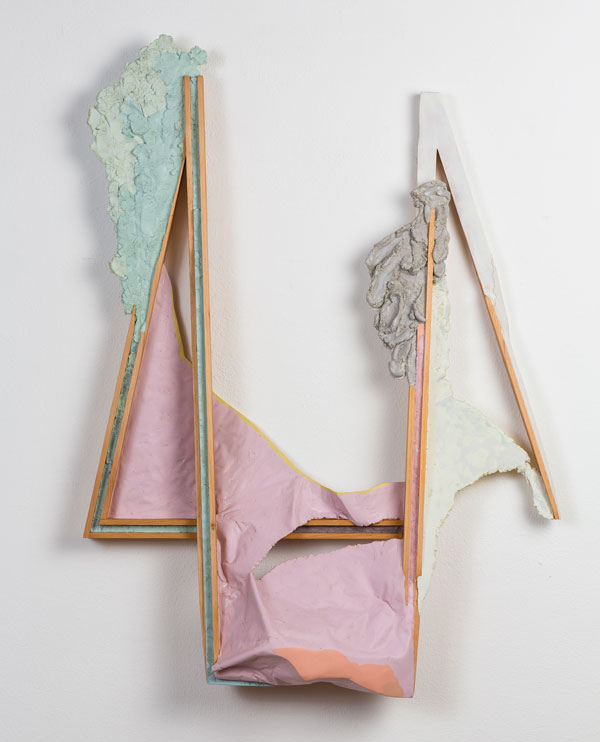In Kafka’s “The Cares of a Family Man,” we meet a small, strange creature lurking on the narrator’s stairway and in his foyer. No animal, but a spool affixed to wooden crosspieces and trailing bits of thread, it’s a “broken-down remnant” composed of scraps, an animated bricolage. When asked its name, it stops rolling and replies, in a voice “like the rustling of fallen leaves… Odradek.”
Some of Kafka’s absurdist humor—gentler in this story than elsewhere—informs Christian Maychack’s mixedmedia artworks. The artist combines painting, sculpture and installation into bricolages that seem almost animate, and playfully subversive. Maychack studied art in the San Francisco Bay Area, and absorbed its traditions of assemblage, trompe-l’oeil illusionism and personal mythology; but also the post-minimalist interest in imbuing emotion and presence into abstract structures; he cites the personal, idiosyncratic work of Jessica Stockholder and Martin Puryear as major influences.
“Reciprocals,” Maychack’s fourth show at Gregory Lind, comprises 11 assemblages, all from 2017: nine wall-hanging reliefs, with two small sculptures mounted on pedestals. They’re small to medium-sized, but charged with energy and humor, reflecting the artist’s interest in interchangeability “between painting and sculpture, front and back, an object and its surroundings… moments of seeming flatness… negative space, the pieces’ irregular shapes… to create a disoriented object.” That phrase may suggest Harold Rosenberg’s term, the “anxious object,” used to describe the experimental works that came after Abstract Expressionism’s existential drama, but did not denote work deliberately provoking anxiety in the viewer. Rosenberg imagines the works pondering, “Am I a masterpiece, or an assemblage of junk?”
Well, maybe both, such is the dichotomous magic of art. Eight of the works—untitled, but numbered—belong to Maychack’s Compound Flats series, begun in 2011, all employing pigmented epoxy clay pressed into the apertures of chair caning, like fossils in a clay matrix. Some viewers saw the clay-embedded caning as photographic, so the pieces had a provocative ambiguity. (Art history mavens will remember that one of Picasso’s 1912 Cubist still-life works employed a printed textile of chair caning to similarly discombobulating ends.)
The new works forgo the chair caning but without loss of complexity. Compound Flat #62 is composed of a rectangle and triangle fashioned from wooden sticks suggestive of stretcher bars that have been combined or superimposed; ridges and fields of red, gray and whitish epoxy clay transform this patched scaffolding into deconstructed painting; Manolo Valdes’ heavily impastoed (and faceless) takes on Renaissance portraiture come to mind. Compound Flat 50, 52, 59, and 58 (subtitled Pink Dropout) are based on stacked double rectangles, suggesting open sash windows—or, again, stretcher bars—divested of their glass or canvas, with swaths of fabric (actually pigmented epoxy) inserted into the mechanisms, holding them in place, or together; the window idea is borrowed, of course, from traditional painting. Perpetual Climber and Compound Flat 60 deviate further from rectangularity into idiosyncratic shapes that perfectly balance the centrifugal, expansive accidents of the creative process with the centripetal, contractile shaping of the organizing aesthetic sensibility.




















0 Comments